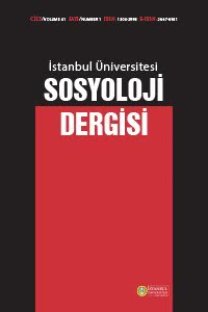Sokaklardan Club lara:Alman-Türk Gençliğinin Müzik Serüveni
Bu çalışma genç kuşak Alman-Türklerin Berlindeki müzik üretiminin dinamikle- rini ele almaktadır. Çalışmanın temel sorusu, bağdaştırıcı kültür yaklaşımı çerçevesinde,kültürel dönüşümün genç kuşağın müzik üretimini nasıl etkileyip değiştirdiğidir. Araştır- ma, özellikle 2000ler ertesinde genç Türk göçmen kuşağın, Berlinin çokkültürlü müziksahnesinde daha görünür hale geldiğini; önceki kuşakların anavatan odaklı müziğindenayrışarak özellikle hiphop ve elektronik müzik alanlarında farklı üretimlere doğru gittiği- ni ortaya koymaktadır. Eski göçmen müziğinin katı diyasporik tonu ile karşılaştırıldı- ğında; yeni kuşakların müziği esnek, açık, farklılıkları hazmeden ve sentezci bir karaktertaşımaktadır.
From Streets to Clubs : A Musical Journey of the German-Turkish Youth
This article examines the dynamics of the music production of German-Turkishyouth in Berlin. Taking into consideration the syncrenic notion of culture, our studyinvestigates how the transition of cultures has affected, altered or transformed the newgeneration of Turkish immigrants way of producing music. This research explores how,especially by the 2000s, Turkish youth is becoming more visible in Berlin s multiculturalmusic scene, and underlines the tendency of especially producing in hiphop and electronicmusic scenes as an alternative to homeland-oriented traditional music. Compared to thetone of older generations music, which represents the rigid diasporic spirit, the music ofthe younger generations is flexible, open, synthesized and accommodates differences.
___
- Abadan-Unat, N. (2002). Bitmeyen göç: Misafir işçiden ulusötesi yurttaşa, İstanbul: Bilgi Üniversitesi.
- Abadan-Unat, N. (1985).Identity crisis of Turkish migrants, Turkish workers in Europe içinde (s. 3-22), I. Basgöz ve N. Furniss (Ed.),Indiana: Indiana University Turkish Studies.
- Abadan, N. (1964).Batı Almanya’daki Türk işçileri ve sorunları, Ankara: DPT.
- Bhabha, H. (1995).Location of culture, Londra: Routledge.
- Castles, S. ve Kosack, K. (1973).Immigrant workers and class structure in Western Europe, Londra: Oxford University.
- Cheesman, T. (1998).Polyglotpolitics: Hip hop in Germany, Debatte, 6(2): 191-214.
- Cohen, R. (1997).Global diasporas: An introduction, Londra: Routledge.
- Çağlar, A. (1998).Popular culture, marginality and institutional incorporation: German-Turkish rap and Turkish pop in Berlin, Cultural Dynamics,10(3): 243–61
- Clifford, J. (1994).Diasporas, CulturalAnthropology, 9(3): 302-338.
- Faist, T. (2000).The volume and Dynamics of international migration and transnational socia lspaces, Oxford: Oxford University.
- Gilroy, Paul, (1987).There ain’t no blackin the Union Jack, Londra:Hutchinson.
- Greve, M. (2006).Almanya’da “hayali Türkiye”nin müziği, İstanbul: Bilgi Üniversitesi.
- Hall, S.(1995). New cultures for old, A place in the world: Places, culture and globalization içinde (s. 175-214), D. Massey ve P. Jess (Ed.), Oxford: Oxford University.
- Hazar, N. (1998). Almanya’da sazın telleri,FremdeHeimat. Eine Geschichte der Einwanderungaus der Türkei içinde (s. 285-297), M. Jamin ve A. Eryılmaz (Ed.), Essen: Klartext.
- Kağıtçıbaşı, Ç. (1987).Alienation of the outsider: The plight of migrants, International Migration, 25(2): 195-210.
- Kaya, A. (2007).German-Turkish transnational space: A separate space of their own, German Studies Review, 30 (3): 1-20.
- Kaya, A. (2001).Constructing diasporas: Turkish hip-hop youth in Berlin, Bielefeld: TranscriftVerlag.
- Kaya, A. (2000).Berlin’deki küçük İstanbul: Diyasporada kimliğin oluşumu, İstanbul: Büke.
- Kaya, A. (1997). Constructing diasporas: Turkish hip-hop youth in Berlin, PhD Dissertation, Centre for Research in Ethnic Relations, University of Warwick.
- Kaya, A. ve Kentel, F. (2005).Euro-Turks: A bridge or a breach between Turkey and the European Union, Brussels: Center for European Policy Studies.
- Lee, R. (2004).Theorizing diasporas: Three typesof consciousness,Asian diasporas, cultures, identities, representations. R. Goh ve S. Wong (Ed.), Hong Kong: Hong Kong University.
- McLaren, P. (1995).Gangs tapedagogy and ghetto ethnicity: The hip-hop nationas counter public space, SocialistReview, 2: 9-55.
- Papastergiadis, N. (2000).The turbulence of migration: Globalization, deterritorialization and hybridity, Londra: Polity.
- Schiller, N. G.,Basch, L. ve Black-Szanton, C. (2004).Transnationalism: A new analytic framework for understanding migration,Migration, globalisation and ethnic relations içinde (s. . 213-227), M. Mobasher ve M. Sadri (Ed.), New Jersey: PrenticeHall.
- Soysal, L. (2004). Rap, hiphop, Kreuzberg: Scripts of / for migrant youth culture in the world city Berlin, New German Critique, 92: 62-81.
- Soysal, L. (2001). Diversity of experience, experience of diversity, Turkish migrant youth culture in Berlin, Cultural Dynamics, 13(1): 5-28.
- Soysal, L. (1999). Projects of culture: An ethnographic episode in the life of migrant youth in Berlin, PhD Dissertation. Department of Anthropology, Harvard University.
- Yurdakul, G. (2002). Bookreview, Critical Sociology, 28 (3): 455-458.
- ISSN: 1304-2998
- Başlangıç: 2020
- Yayıncı: İstanbul Üniv. Edebiyat Fak. Sosyoloji Böl.
Sayıdaki Diğer Makaleler
Dayanışma Ağları Üzerinden Eskişehir'de Siyaset ve Göçmenlik Algısı
Avrupa'daki Türkiyeli Göçmenlerin Ulusaşırı Aile Ağları
Transnational Family Networks of Migrants from Turkey in Europe
Antalya'daki Rus Gelinler: Göçten Evliliğe, Evlilikten Göçe
Ağrılı Göçmenlerin Fransa'ya Tutunma Stratejileri
Karşı İstikametten Göç: Türkiye'deki Yüksek Vasıflı Alman Kadınlar
British Asian Youth, Urban Protests and Local Belongingness
Sokaklardan Club lara:Alman-Türk Gençliğinin Müzik Serüveni
